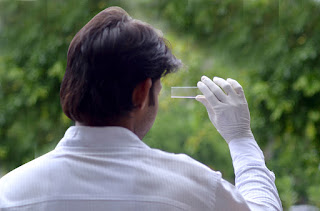FTO Coated glass
is electrically conductive, colour neutral glass, widely used in electronic and
several other industries. For example it is commonly seen used in touch screen
displays, thin film photovoltaic, energy-saving windows, opto-electronics,
RFI/EMI shielding and several insulating applications. Before placing an order
one must reconfirm the precise glass thicknesses and surface resistivity one
requires.
 As far as cleaning the FTO glass is
concerned, there are many different ways to do it. What works for some people,
doesn’t quite work for others. We are listing down various ways that we have
found and are being used to clean FTO glass. We are sharing them here as a way
to provide information leaving it to you to use the one that suits you best.
As far as cleaning the FTO glass is
concerned, there are many different ways to do it. What works for some people,
doesn’t quite work for others. We are listing down various ways that we have
found and are being used to clean FTO glass. We are sharing them here as a way
to provide information leaving it to you to use the one that suits you best. This is how one can safely clean FTO coated glass for electrochemical deposition. There is a set of people who feel comfortable using the same process and material that they use for cleaning ITO coated glass, i.e. they do ultrasonic cleaning with ethanol, acetone and dry water. On the other hand there are people who don’t prefer use of acetone to clean FTO because they feel that it is likely to adsorb onto the electrode, giving ruse to spots of non deposition.
Then there is another method where in the substrate is washed
with cotton & neutral liquid detergent; followed by rinsing it thoroughly
with another cotton, using enough water; again washing/rinsing it with ethanol
twice in the US bath for about half a minute, concluding wash with DI water 2
times in the same bath for a half a minute each. Then dry it with nitrogen. If
the FTO substrate is cut, then you have to be extra careful as there is a
chance that US may break the borders and creates glass needles that may scratch
your FTO, damaging the deposition.
Some people simply wash the FTO glass for half a minute in Piranha, but several who have experimented with Piranha
claim that it etches FTO.
FTO glass can also
be cleaned by taking it through RCA treatment, which is a mild cleaning process
and works well for both ITP as well as FTO and which helps to removes organic
impurities from the surface. It is suggested to take 1: 1: 5 volume ratio of
NH3, 30% H2O2 and H2O; to be heated at 70-80 degree
C for 15 minutes, thereafter rinsing it in DI water 3-4 times. Degreasing in
hot ( ̴600C) saturated KOH in isopropanol is also
a sought after FTO cleaning process.
Use methods you feel most comfortable with
or if you have derived a unique and effective method of cleaning FTO glass,
feel free to share with us and other readers.


